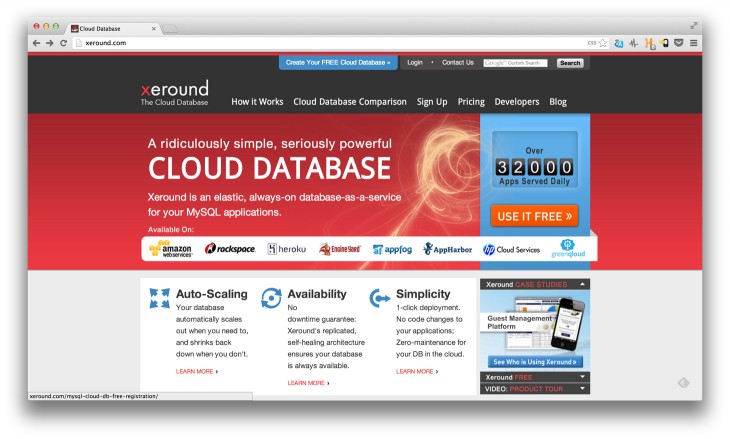
Editor’s note: This story was written by Henn Idan and Yaniv Feldman, and was originally published in Hebrew by Newsgeek, the largest tech blog In Israel.
Earlier this week, Israeli start-up Xeround, announced it will shortly be closing its doors. Xeround, which provides a cloud model database as a service solution (DaaS), informed users on its official company blog that free users will have just one week to move all their data to another database provider. Paying customers were given a little more breathing room, and are expected to have their bags packed and their beds turned over by the 15th of the month.
While no details were given as to the reason they decided to close up shop, company officials hinted to the fact that management has decided to re-focus the company’s efforts, and as of the dates specified, will no longer be providing any more support for its services.
What happens when you over-pivot
Xeround was founded in 2005 by Sharon Barkai – founder of Sheer networks, which was eventually sold to Cisco , and Dr. Gilad Zlotkin – founder of Class Data, also sold to Cisco. Originally, the company started out developing SS7 Gateway type communications components. When they realized this direction wasn’t getting them anywhere, they pivoted, choosing to focus on designing databases geared toward handling large information loads with fast response times and high survivability (Real Time Carrier Grade Telco Database).
Comparing the advances of Xeround with what was available at the time, when the Clusters models of Oracle and Microsoft were not as stable as they are today, it looked like Xeround really had a qualitative advantage over its powerhouse competitors.
For two and a half years Xeround tried to push their solution as an OEM product to major telecom companies like Ericsson, Siemens and Nokia, but the red tape involved when dealing with major providers made the process excruciatingly long. Xeround then looked to branch out, seeking to partner directly with other media companies within Israel, and AT&T in the United States.
“Ultimately, this too proved fruitless, because the fact was, Xeround was the scrappy new startup trying to play hardball with the older boys, and despite having what to offer, they were never really given the chance to show it off. They learned early on that trying to tangle with customers used to working with the likes of Microsoft and Oracle, was not an easy task. Sales cycles were long and unpredictable. Massive amounts of time, money and resources were being poured into customer demos and trials, only to find out, that at the end of the day, decisions were being made based on political considerations or the like, and had nothing to do with who can actually provide the best solution for the company. Xeround was out of their element.” a source close to Xeround told Newsgeek.
At this point, investors looked to pivot once again, keeping the technology but reconsidering their target market. Charlotte Yarkoni – a senior exec at Amdocs, was asked to take over as CEO, and see if she could turn Xeround into a sort of ‘mini Amdocs’. She was not to focus so much on the product, but rather on the end users, and see if she could broaden the base of who could and should be benefiting from what Xeround had to offer. Yarkoni managed to secure two U.S. funds and recruit the single largest investment of the company, nearly $16 million. By now, the product was already very polished and the main focus of all company efforts shifted to closing deals with other companies in the form of developmental integration.
This strategy worked for the better part of two years, but once again, the beurocracies of large organizations came back to haunt Xeround with a vengeance. The straw that broke the camel’s back was a big contractual project that had been running smoothly for 8 months with Amdocs and AT&T, which suddenly fell through, shutting down in a single day.
“Hundreds of millions of dollars that we counted on, was suddenly cut off. Other than a few dollars coming in here and there to cover costs, we were basically running dry,” Newsgeek’s source says. “Shortly after we lost the project, she [Yarkoni] also left and a lot of the money she raised went with her. She took all the people dealing with it, leaving the company with no money and no infrastructure.”

Three years ago, the investors tried to take matters into their own hands, and brought in a new general manager named Razi Sharir to try and take the company’s technology to the hottest new party on the block at the time, the Cloud. The idea was to try and provide the same database service advantages of speed, enterprising growth capacity etc. – while bypassing the larger customers with all their baggage of time and cost constraints, by opening up Xeround’s services to all size customers in the form of an SaaS model.
Like a Shakespearean tragedy, the new model proved as faulty as the others. First, the company tried to establish its own server farm but quickly nixed that idea after calculating the real costs involved. When other cloud service providers started competing in the same space with similar products, Xeround decided to throw in the towel for good.
“This last idea had potential. If you’re looking for a place to lay blame, it’s with the investors and senior management, chasing their own tails and not knowing where they were going from one day to the next,” Newsgeek’s source says.
“Nothing ever filtered down properly to the operational employees. You need to remember that when Xeround first opened up shop, the plan was to sell its product to large companies. Much about Xeround’s products were designed with the assumption that someone else would eventually be responsible for them. Jumping right into the cloud with the idea that everything would just be converted to a smaller user, SaaS model, was unrealistic. Xeround had to bundle their services with a cloud provider, and to make that work properly costs money. It turned out that the backend operational expenses wound up costing more than Xeround was actually bringing in from their customers. You don’t need an MBA to realize that this sort of business model wasn’t going to work.”
A year ago, Xeround managed to raise yet another round of funding, buying it one last chance to tap its unrealized potential. However, six months ago, we began to notice significant reductions and layoffs in the company, culminating in what was the dramatic ‘closure of service’ announcement last weekend. Overall, during its eight year run, Xeround raised a relatively high amount of capital, about $34 million from VC firms like Israeli Giza, Benchmark Capital, Ignition Partners and Trilogy Partnership. In its last days the company employed close to 40 people at its offices in Yehud and the United States.
According to information received by Geektime, most employees had already been informed about the fate of the company on the day before the official announcement on their blog. Apparently, a number of senior employees were left on hand to wrap up unfinished business, probably involving the selling off of assets and other such liquidable items before the final close. There have been reports of late, of some larger deals being closed by Xeround with the kind of big scale clients they’ve had so much trouble trying to hook in the past, but apparently it was too little too late, and the trajectory of the company could no longer be changed.
We turned to the company for comment, but did not hear back from them as of this writing. Should we get more information, we will update the post at that time.
So what do we do now?
The biggest question surrounding Xeround is not necessarily why the company closed, but what are their customers supposed to do now. The risks in dealing with startups are well known, and anyone looking to entrust their business to a startup is fully aware that such a company can go belly-up at any moment, ditching them in the middle of the road to find their own way home. However, it’s not often that a well-funded organization hangs up a ‘closed’ shingle on their doors one morning without so much as a ‘heads up’.
For users, or even companies, who base their services on a startup like Xeround, a closure like this can be fatal. Loss of business, the need to search for a new provider ASAP, dozens of minor emergencies are created, each one costing precious cash that individuals and startups simply don’t have. Sometimes companies base entire business models on the assumption that a certain company’s services will exist for the foreseeable future. When one day it doesn’t, neither do the companies who relied on it.
It’s important to clarify that this is a problem without any clear solution. Investing solely in well established companies and ignoring startups will only serve to make startups superfluous. With no customers to speak of, investment would dry up and startups would soon disappear, taking with them all the price points and innovation that they bring along with them to the table. On the other hand, the risk is always there – and when a well-funded, 8-year-old startup can’t make it work, it makes you think twice about using the really small startups for your business operations.
Bottom line: selecting the technology solution of a young startup can be equated to investing shares in their company. There’s risk involved, but also plenty of benefits if they succeed. Stepping back a bit and looking at this thing objectively, we believe that just like you’d want someone to invest in you, you yourself must continue to invest in others – small as they are. But make sure to have a backup plan in place, so you don’t find yourself stranded on the side of the road with your thumb sticking out.
Image credit: Adam Gault / Thinkstock
Get the TNW newsletter
Get the most important tech news in your inbox each week.




